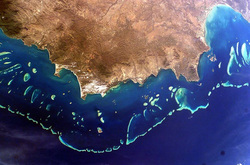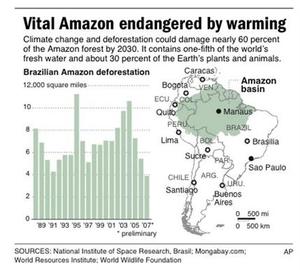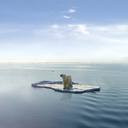Intergovernmental Panel on Climate Change: Regional Impacts
|
|
Contribution of Working Group II to the 2007 Fourth Assessment Report of the International Panel on Climate Change Summary for Policymakers
- Highlights of Projected Regional Impacts- Africa - Asia - Europe - Small Islands - Australia and New Zealand - North America - Latin America - Polar Regions *Select specific regions for more detailed impact descriptions |
|
"Climate change is for real. We have just a small window of opportunity and it is closing rather rapidly. There is not a moment to lose." ~Dr. Rajendra Pachauri, Chairman, Intergovernmental Panel on Climate Change
|
|
|
Himalayan Glaciers Melting Faster Than Anywhere Else in World - Impact Could Devastate Over 1 Billion People. Learn more. According to a UN climate report, the Himalayan glaciers, which are the sources of Asia's biggest rivers, the Ganges, Indus, Brahmaputra, Yangtze, Mekong, Salween and Yellow, could disappear by 2035 as temperatures rise. Approximately three billion people live in the drainage basin of the Himalayan rivers, which is almost half of the current human population. Learn more.
|
|
"Industrialized, chemical-intensive agriculture and our globalized system of distributing food and fiber are literally destroying the earth, driving two billion farmers off the land, and producing a product which is increasingly contaminated. That's why the wave of the future is organic and sustainable, not GMO."
~Ronnie Cummins, Organic Consumers Association
~Ronnie Cummins, Organic Consumers Association
|
|
|
|
"We find ourselves ethically destitute just when, for the first time, we are faced with ultimacy, the irreversible closing down of the earth's functioning in its major life systems. Our ethical traditions know how to deal with suicide, homicide and even genocide, but these traditions collapse entirely when confronted with biocide, the killing of the life systems of the earth, and geocide, the devastation of the earth itself." ~Father Thomas Berry
|
Sun Come Up Trailer - Carteret Islanders "Sun Come Up is an ACADEMY AWARD® nominated film that shows the human face of climate change. The film follows the relocation of the Carteret Islanders, a community living on a remote island chain in the South Pacific Ocean, and now, some of the world’s first environmental refugees. When climate change threatens their survival, the islanders face a painful decision. They must leave their ancestral land in search of a new place to call home. Sun Come Up follows a group of young islanders as they search for land and build relationships in war-torn Bougainville, 50 miles across the open ocean." ~ Sun Come Up |
|
“Sea-level rise is expected to exacerbate inundation, storm surge, erosion and other coastal hazards, thus threatening vital infrastructure, settlements and facilities that support the livelihood of island communities (very high confidence).” ~IPCC AR4
|
|
|
"When the earth is sick and polluted, human health is impossible.... To heal ourselves we must heal our planet, and to heal our planet we must heal ourselves." ~Bobby McLeod
|
Australia Environmental Issues Map
In 2007, the Commonwealth Scientific and Industrial Research Organization (CSIRO), an Australian government organization, reported that by 2020 there could be 65% more extreme fire danger days than in 1990. By 2050, according to the CSIRO report, the increase could be as high as 300%. Learn more. Scientists and environmentalists alike are warning Australians to brace for more extreme weather in the future due to increasing climate change. Learn more. |
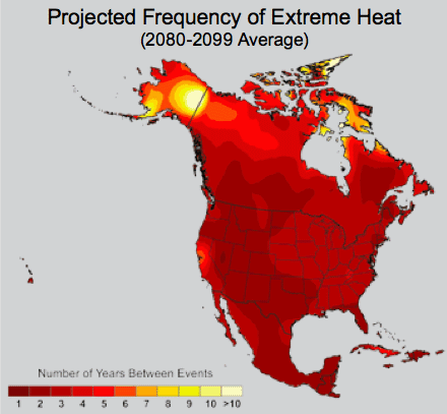
Simulations for 2080-2099 indicate how currently rare extremes (a 1-in-20-year event) are projected to become more commonplace. A day so hot that it is currently experienced once every 20 years would occur every other year or more frequently by the end of the century under the higher emissions scenario. Image credit: U.S. Global Change Program Impacts Report, 2009 | Click to enlarge
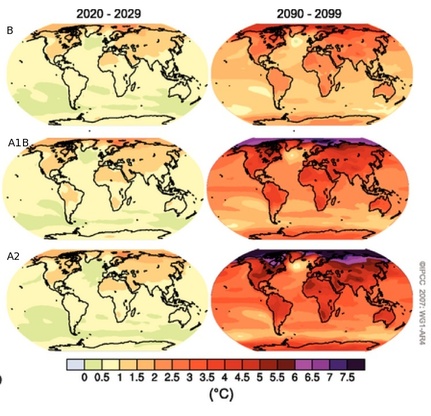
Figure: Projected surface temperature changes for the early and late 21st century relative to the period 1980 to 1999. The left and right panels show the AOGCM multi-model average projections (°C) for the B1 (top), A1B (middle) and A2 (bottom) SRES scenarios averaged over the decades 2020 to 2029 (centre) and 2090 to 2099 (right). Adapted from Figure TS.28 in Solomon, S., and Coauthors: Technical Summary. In: Climate Change 2007: The Physical Science Basis. Contribution of Working Group I to the Fourth Assessment Report of the Intergovernmental Panel on Climate Change [Solomon, S., D. Qin, M. Manning, Z. Chen, M. Marquis, K.B. Averyt, M. Tignor and H.L. Miller (eds.) | Click to enlarge
|
Glacier Retreat
Snowpack declines in the northern Rocky Mountains and upper Columbia River region are "almost unprecedented" in magnitude in the past 800 years, according to a study of tree ring data released by the journal Science in a peer-reviewed study asserting that man-made global warming is having an increased impact on snowpack. In much of the Northwest, snowpack is crucial for drinking water, hydropower, irrigation water and summer streamflows that support cold-water fish such as salmon and steelhead. Learn more.
powered by Fotopedia "Global warming is bringing more frequent and severe heat waves, and the result will be serious for vulnerable populations. That means air pollution in urban areas could get worse, bringing increased risk of heart attacks, strokes and asthma attacks. Children, the elderly, poor, and people of color are especially vulnerable to these effects." ~Dr. Amanda Staudt, National Wildlife Federation Climate Scientist |
"Human activities are increasingly altering the Earth's climate.... It is virtually certain that increasing atmospheric concentrations of carbon dioxide and other greenhouse gases will cause global surface climate to be warmer. The unprecedented increases in greenhouse gas concentrations, together with other human influences on climate over the past century and those anticipated for the future, constitute a real basis for concern." ~American Geophysical Union
"Each one of the Earth's 5 million invertebrate species plays a role in its ecosystem. It's like we're tearing the cogs out of a great machine. The machine might work after you tear out ten cogs, but what happens when you tear out a hundred?" ~Scott Black, Xerces Society
|
"There are currently between 25-30 million environmental refugees worldwide, and their numbers are expected to swell to 200 million by mid-century, largely as a result of climate change." ~Climate Institute
|
|
|
Last Revised: 11/20/13
Commenting Rules |






